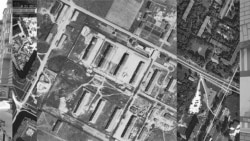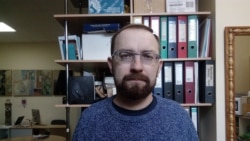PSKOV, Russia -- The general public in this northwestern Russian city about 750 kilometers from Moscow first found out that something was strange about a construction site in the neighborhood of Zavelichye back in 2006 -- when kids went out to play and brought back human bones.
During World War II, a horrific Nazi prisoner-of-war camp, or stalag, was located there.
“City residents learned about the mass burials on the grounds of the former stalag when children playing at the construction site started bringing home the skulls and bones of prisoners of war that they found in the foundation pits,” Lev Alekseyev, head of a local NGO called Reliable History, wrote in a March 5 application to city authorities requesting that the area be granted state protection as a unique historical site.
Construction proceeded on the site, which was controlled by the Russian Defense Ministry, until 2011. By the time a public campaign succeeded in freezing the building of housing for officers and their families, 12 high-rise apartment blocks and a kindergarten had been built over about half of the site of Stalag 372.
The activists rejoiced in early 2014 when municipal lawmakers published a “development road map” that envisioned the creation of a memorial complex at the site, although the initiative never went far. To the present day, only a modest granite marker indicates the dark significance of the site.
Recently, however, the Russian Defense Ministry applied to the city to change the site’s status and allow construction to resume, arguing that a single unit on the national Land Cadastre cannot be partially a residential zone and partially a protected memorial site.
That development prompted the local activists to seek national protected status for the remaining undisturbed portion of the site.
“We understood the obvious,” historian Andrei Ivanov, who has researched the history of Stalag 372, told RFE/RL. “The military doesn’t care at all what bones are buried there or what POW camp was there. We are afraid we’ll see the same situation that we saw in 2010, when the bones were dug up and dumped God knows where. In order to prevent any work on this land, we want the zone to be protected with federal status. Then the military won’t have to deal just with city regulations, but with federal law.”
The matter has particular urgency, the activists say, because in May the country will mark the 75th anniversary of the defeat of Nazi Germany and commemorate the estimated 25 million or more Soviet citizens who were killed during the conflict.
Stalag 372 is a chilling, forgotten page in the history of that conflict. When Hitler’s forces invaded the Soviet Union in June 1941, they expected a swift victory. They were not prepared to handle the millions of Soviet prisoners who were captured in the early months of the war and held for years.
'Hunger Was Rampant'
From autumn 1941 until December 1943, the Germans ran the POW camp in Pskov in the stables of the 5th Omsk Infantry Regiment. Thirty buildings -- each 84 meters by 23 meters -- housed around 2,000 prisoners apiece.
“Horrific hunger was rampant,” wrote researcher Marina Safronova in an article on the camp. “The daily bread ration was 75 to 100 grams.” (A stack of 10 one-euro coins weighs 75 grams; During the darkest days of the siege of Leningrad, the bread ration was 125 grams.)
In late 1943 and early 1944, the Nazis used the camp as a transit point for shipping Soviet civilians to work in Germany and the occupied countries.
Galina Ivanova, a Pskov resident who was 13 when she found herself interned in the camp, says she will never forget what she endured there.
“They didn’t feed us in the camp,” she told RFE/RL. “There was a faucet there and you can imagine the line of people trying to get some water. And the lice! It was horrible…. The rats and the lice and all those hungry people.”
A military commission investigated the camp in April 1945, establishing the location of 10 mass-burial sites as well as several facilities the Germans used to destroy corpses “to cover up their crimes.” The commission found that at times the population of the camp exceeded 100,000 people and that an estimated 75,000 people were buried there. “They died of hunger, execution, and blunt-force injuries,” the commission’s report found.
In 1945, about 650 bodies were exhumed and reburied.
President Vladimir Putin and his government have used the sacrifice of Soviet soldiers who died in World War II as a lever to seek unity on the basis of patriotic sentiment in Russia, where few families were left untouched by the conflict, and often stressed that their memory is inviolable.
But on the whole, the story of Soviet POWs is a blank spot in the war’s history, in part due to the stigma placed on prisoners by Josef Stalin.
Stalin’s government gave a general “do not surrender” order at the beginning of the war and paid little attention to its captured forces. The Soviet Union was not a party to the Geneva Conventions, so its prisoners did not receive protection and assistance from the Red Cross.
In all, about 5.3 million Soviet soldiers were captured during the war and about half of them died in German captivity. Many who returned to the Soviet Union after the war were dispatched to Stalin’s gulag camps, branded traitors and cowards.
The Pskov site was largely undisturbed until the early 2000s, when the city’s growth brought it into attractive commuting distance from the city center. When the remains of the prisoners began surfacing in 2006, activists were able to conduct some research at the site. An additional 243 bodies were reinterred.
“We discovered trenches with bodies running from [one high rise] to a new playground,” historian Aleksei Starkov, who participated in the 2006 excavations, said. “The bodies are still there. The Germans set them on fire and buried them -- now children’s playground equipment is there.”
Oblivion, historian Ivanov says, is an injustice to those who died there.
“These prisoners were treated inhumanly, but they did not lose their honor. They were constantly invited to join the Russian Liberation Army,” he said, referring to a military formation led by General Andrei Vlasov that was largely recruited from Soviet prisoners to fight alongside the Germans against the Soviet Union. “Or to work in Germany.”
“But the ones who are lying here made the conscious decision to die rather than to submit,” Ivanov noted.















